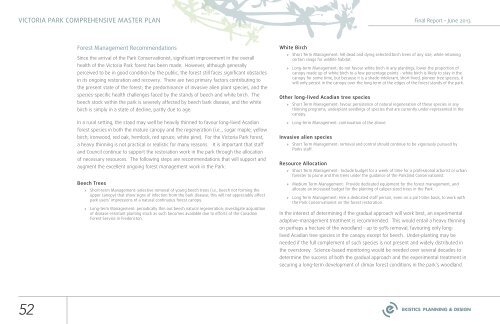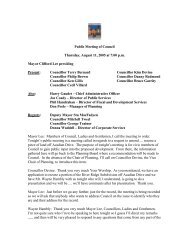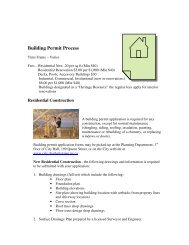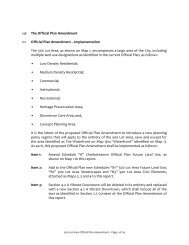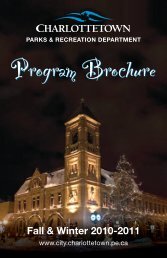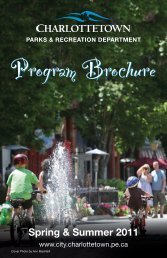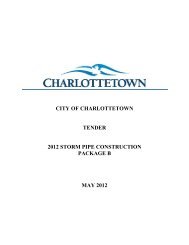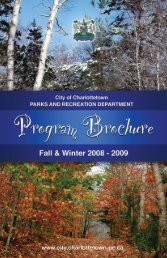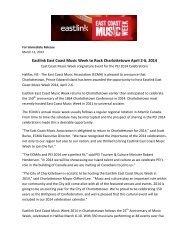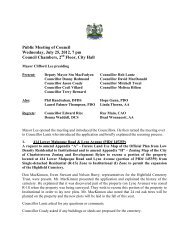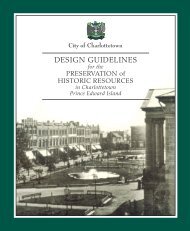Victoria_Park_Re port Final.pdf - City of Charlottetown
Victoria_Park_Re port Final.pdf - City of Charlottetown
Victoria_Park_Re port Final.pdf - City of Charlottetown
You also want an ePaper? Increase the reach of your titles
YUMPU automatically turns print PDFs into web optimized ePapers that Google loves.
VICTORIA PARK COMPREHENSIVE MASTER PLAN<br />
<strong>Final</strong> <strong>Re</strong><strong>port</strong> • June 2013<br />
Forest Management <strong>Re</strong>commendations<br />
Since the arrival <strong>of</strong> the <strong>Park</strong> Conservationist, significant improvement in the overall<br />
health <strong>of</strong> the <strong>Victoria</strong> <strong>Park</strong> forest has been made. However, although generally<br />
perceived to be in good condition by the public, the forest still faces significant obstacles<br />
in its ongoing restoration and recovery. There are two primary factors contributing to<br />
the present state <strong>of</strong> the forest; the predominance <strong>of</strong> invasive alien plant species, and the<br />
species-specific health challenges faced by the stands <strong>of</strong> beech and white birch. The<br />
beech stock within the park is severely affected by beech bark disease, and the white<br />
birch is simply in a state <strong>of</strong> decline, partly due to age.<br />
In a rural setting, the stand may well be heavily thinned to favour long-lived Acadian<br />
forest species in both the mature canopy and the regeneration (i.e.., sugar maple, yellow<br />
birch, ironwood, red oak, hemlock, red spruce, white pine). For the <strong>Victoria</strong> <strong>Park</strong> forest,<br />
a heavy thinning is not practical or realistic for many reasons. It is im<strong>port</strong>ant that staff<br />
and Council continue to sup<strong>port</strong> the restoration work in the park through the allocation<br />
<strong>of</strong> necessary resources. The following steps are recommendations that will sup<strong>port</strong> and<br />
augment the excellent ongoing forest management work in the <strong>Park</strong>:<br />
Beech Trees<br />
»»<br />
Short-term Management: selective removal <strong>of</strong> young beech trees (i.e., beech not forming the<br />
upper canopy) that show signs <strong>of</strong> infection from the bark disease; this will not appreciably affect<br />
park users’ impressions <strong>of</strong> a natural continuous forest canopy.<br />
»»<br />
Long-term Management: periodically thin out beech natural regeneration; investigate acquisition<br />
<strong>of</strong> disease-resistant planting stock as such becomes available due to efforts <strong>of</strong> the Canadian<br />
Forest Service in Fredericton.<br />
White Birch<br />
»»<br />
Short Term Management: fell dead and dying selected birch trees <strong>of</strong> any size, while retaining<br />
certain snags for wildlife habitat.<br />
»»<br />
Long-term Management: do not favour white birch in any plantings; lower the pro<strong>port</strong>ion <strong>of</strong><br />
canopy made up <strong>of</strong> white birch to a few percentage points - white birch is likely to stay in the<br />
canopy for some time, but because it is a shade-intolerant, short-lived, pioneer tree species, it<br />
will only persist in the canopy over the long term at the edges <strong>of</strong> the forest stands <strong>of</strong> the park.<br />
Other long-lived Acadian tree species<br />
»»<br />
Short Term Management: favour persistence <strong>of</strong> natural regeneration <strong>of</strong> these species in any<br />
thinning programs; underplant seedlings <strong>of</strong> species that are currently under-represented in the<br />
canopy.<br />
»»<br />
Long-term Management: continuation <strong>of</strong> the above.<br />
Invasive alien species<br />
»»<br />
Short Term Management: removal and control should continue to be vigorously pursued by<br />
<strong>Park</strong>s staff.<br />
<strong>Re</strong>source Allocation<br />
»»<br />
Short Term Management: Include budget for a week <strong>of</strong> time for a pr<strong>of</strong>essional arborist or urban<br />
forester to prune and thin trees under the guidance <strong>of</strong> the <strong>Park</strong>land Conservationist.<br />
»»<br />
Medium Term Management: Provide dedicated equipment for the forest management, and<br />
allocate an increased budget for the planting <strong>of</strong> caliper-sized trees in the <strong>Park</strong>.<br />
»»<br />
Long Term Management: Hire a dedicated staff person, even on a part-time basis, to work with<br />
the <strong>Park</strong> Conservationist on the forest restoration.<br />
In the interest <strong>of</strong> determining if the gradual approach will work best, an experimental<br />
adaptive-management treatment is recommended. This would entail a heavy thinning<br />
on perhaps a hectare <strong>of</strong> the woodland - up to 50% removal, favouring only longlived<br />
Acadian tree species in the canopy except for beech. Under-planting may be<br />
needed if the full complement <strong>of</strong> such species is not present and widely distributed in<br />
the overstorey. Science-based monitoring would be needed over several decades to<br />
determine the success <strong>of</strong> both the gradual approach and the experimental treatment in<br />
securing a long-term development <strong>of</strong> climax forest conditions in the park’s woodland.<br />
52


